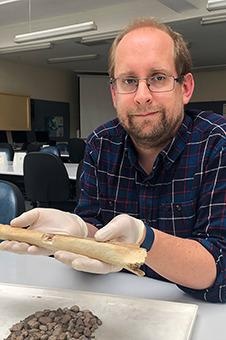Researchers at the University of Otago have developed a novel technique for acquiring ancient genomic data without causing damage to the source material, opening up new possibilities for museum and archaeological collections around the world.
 Dr Nic Rawlence. Image Credit: University of Otago
Dr Nic Rawlence. Image Credit: University of Otago
Ancient DNA doesn’t have to be destructive. Our new method allows the reconstruction of genetic whakapapa without destroying the very bone that’s kept its secrets for thousands of years.”
Lachie Scarsbrook, Study Lead Author, University of Otago
The study, which was published in the international journal Molecular Ecology, describes a novel method for extracting genomic data from small vertebrate remains that produce no external damage to the underlying bone.
“This will not only facilitate analyses on materials in museum collections that are either too small to be destructively sampled but also more rare and valuable materials, both culturally and scientifically.”
Lachie Scarsbrook, Study Lead Author, University of Otago
The research used current and exterminated populations of Hoplodactylus geckos as a case study and symbolizes the first mitochondrial genomes acquired for any New Zealand lizard. The study was performed while Mr Scarsbrook was completing a Master of Science in the Department of Zoology.
Researchers were able to fully understand and demonstrate how tectonic activity, climate change, and human impact have affected Duvaucel’s gecko (Hoplodactylus duvauceli) populations regionally within New Zealand using newly sequenced DNA data.
Deep splits between North and South Island populations reflect long-term isolation before the formation of Cook Strait, while South Island populations show genetic breaks geographically consistent with maximum ice coverage during the height of the last Ice Age.”
Lachie Scarsbrook, Study Lead Author, University of Otago
“The significant loss of genetic diversity in both North and South Island populations is testament to the impact of humans and introduced predators. Our research is having meaningful and direct impacts on the conservation management of Duvaucel’s gecko,” Mr Scarsbrook added.
Dr Nic Rawlence of the Otago Palaeogenetics Laboratory, the study’s supervisor and co-author, says one of the study’s findings is that understanding of New Zealand’s geckos at the time of human arrival is now a blank slate.
“It was previously thought that you could only distinguish between bones of different gecko species based on size, but amazingly CT scans and ancient DNA showed that we could in fact distinguish different geckos using shape alone—size got thrown out with the bathwater,” Dr Rawlence says.
“It turns out size doesn’t matter after all, meaning what we know about New Zealand’s geckos at the time of human arrival is now a palaeontological clean slate.”
Mr Scarsbrook, who is finishing his DPhil at the University of Oxford’s Palaeogenomics and Bio-Archaeology Research Network, says the study also conveys the process of creating scientific advancement.
“We first attempted to obtain mitochondrial genomes using a different method, and after months of time in the laboratory, we failed to produce usable data,” Mr Scarsbrook added.
Mr Scarsbrook further states, “After going back to the drawing board and making some changes we achieved our goal, which just goes to show that perseverance in the face of failure is key if you’re going to help make scientific advancements.”
In collaboration with the Department of Conservation and Māori iwi, Dr Rawlence asserts the ongoing research program will use these new methods to recreate the lost ecological history of New Zealand’s gecko and skinks (where size-based identification has confounded researchers), frogs, and tuatara.
“The long-term conservation of finite specimens is of huge concern to curators globally, so what Lachie has developed will not only unlock molecular secrets but potentially vast swaths of natural history and archaeological collections globally to similar genetic analysis,” Dr Rawlence concludes.